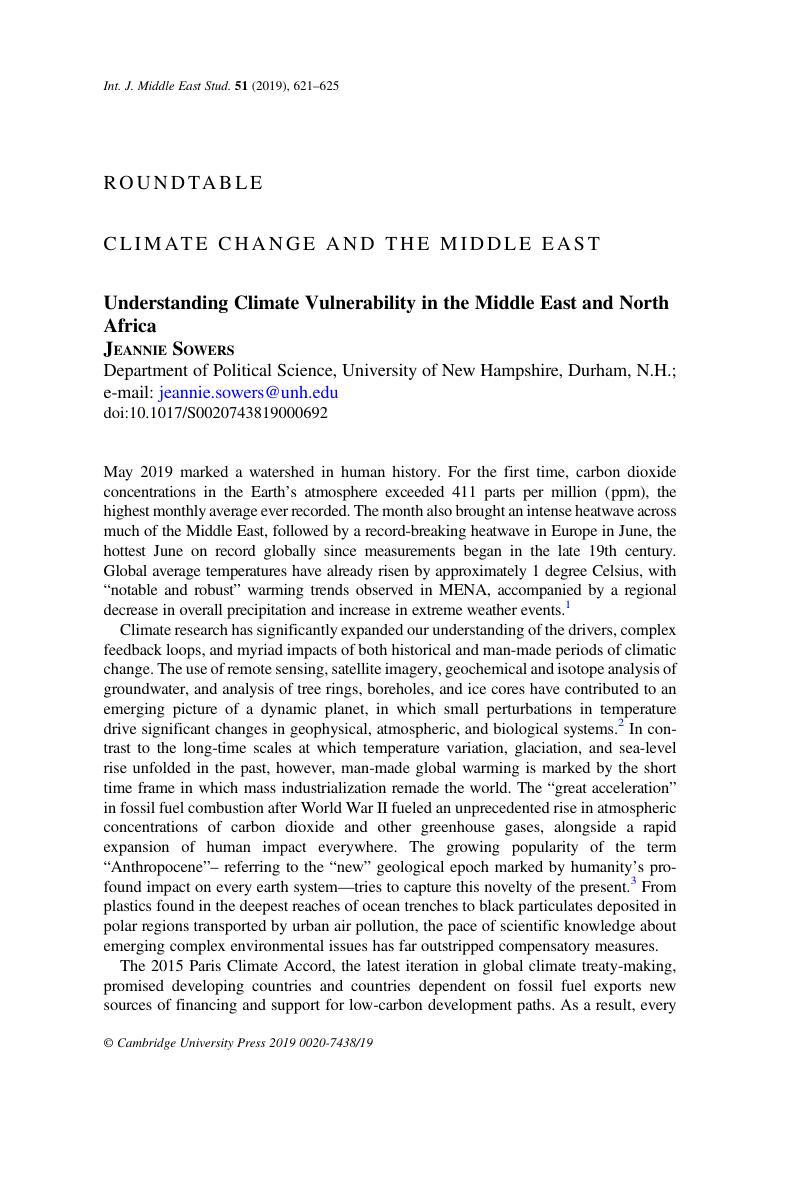Article contents
Understanding Climate Vulnerability in the Middle East and North Africa
Published online by Cambridge University Press: 02 October 2019
Abstract

- Type
- Roundtable
- Information
- Copyright
- Copyright © Cambridge University Press 2019
References
NOTES
Author's note: My thanks to Erika Weinthal for her insightful comments on early drafts and Yosua Siagian for his research assistance collecting National Communications to the United Nations Framework Convention on Climate Change (UNFCC) by MENA states.
1 Intergovernmental Panel on Climate Change (IPCC), AR5 Climate Change 2014, Impacts, Adaptation, and Vulnerability, chap. 24, “Asia,” https://www.ipcc.ch/site/assets/uploads/2018/02/WGIIAR5-Chap24_FINAL.pdf, p. 1333.
2 For a review, see Moufouma-Okia, Wilfran, Masson-Delmotte, Valérie, Zhai, Panmao, Pirani, Anna, and Chen, Yang, “Recent Progress and Emerging Topics on Weather and Climate Extremes Since the Fifth Assessment Report of the Intergovernmental Panel on Climate Change,” Annual Review of Environment and Resources 43 (2018): 35–59Google Scholar.
3 A 2015 article argues that in the geological record, the post-1945 detonation of nuclear bombs until suspended in 1988 has generated globally detectable radionuclides that can mark the Anthropocene in the geological record; Zalasiewicz, Jan et al. , “When Did the Anthropocene Begin? A Mid-Twentieth Century Boundary Level is Stratigraphically Optimal,” Quaternary International 383 (2015): 196–203CrossRefGoogle Scholar, https://doi.org/10.1016/j.quaint.2014.11.045.
4 Like most national communications from developing countries (non-Annex I), the reports were prepared and submitted by local and expatriate experts, often through environmental consulting firms, funded by the Global Environment Facility and technically supported by the United Nations Development Program (UNDP).
5 Sowers, Jeannie, “Environmental Activism in the Middle East and North Africa,” in Environmental Politics in the Middle East, ed. Verhoeven, Harry (Oxford: Oxford University Press/Hurst Publishers, 2018), 27–52CrossRefGoogle Scholar.
6 Tunisia's Third National Communication as Part of the United Nations Framework Convention on Climate Change, Ministry of Local Affairs and the Environment, 2019, pp. 9, 25.
7 Egypt's Third National Communication Under the United Nations Framework Convention for Climate Change, Ministry of State for Environmental Affairs and Egyptian Environmental Affairs Agency, March 2016.
8 Mason, Michael, Zeitoun, Mark, and Mimi, Ziad, “Compounding Vulnerability: Impacts of Climate Change on Palestinians in the West Bank and Gaza,” Journal of Palestine Studies 41 (2012): 40Google Scholar.
9 For early critiques of simplistic framings that attributed the Syrian conflict to climate change, see Jeannie Sowers, John Waterbury, and Eckart Woertz, “Did Drought Trigger the Crisis in Syria?,” Footnote, 12 September 2013, accessed June 27 2019, http://footnote1.com/did-drought-trigger-the-crisis-in-syria/; Woertz, Eckart, “Environment, Food Security and Conflict Narratives in the Middle East,” Global Environment 7 (2014), 10.3197/ge.2014.070209CrossRefGoogle Scholar; and Weinthal, Erika, Zawahri, Neda, and Sowers, Jeannie, “Securitizing Water, Climate, and Migration in Syria, Jordan, and Israel,” International Environmental Agreements: Politics, Law and Economics 15 (2015): 293–307, 10.1007/s10784-015-9279-4CrossRefGoogle Scholar. For thorough critique of the conflict-climate thesis for the Syrian case, see Selby, Jan, “Climate Change and the Syrian Civil War, Part II: The Jazira's Agrarian Crisis,” Geoforum (2018), 10.1016/j.geoforum.2018.06.010Google Scholar; Selby, Jan, Dahi, Omar, Fröhlich, Christiane, and Hulme, Mike, “Climate Change and the Syrian Civil War Revisited: A Rejoinder,” Political Geography 60 (2017): 253–55CrossRefGoogle Scholar; and Selby, Jan, Dahi, Omar, Fröhlich, Christiane, and Hulme, Mike, “Climate Change and the Syrian Civil War Revisited, Political Geography 60 (2017): 251–52Google Scholar.
10 Third National Communication to the IPCC, Republic of Yemen, June 2018, p. 4.
11 See Martha Mundy, “Strategies of the Coalition in the Yemen War: Aerial Bombardment and Food War,” World Peace Foundation, 9 October 2018; tallies of civilian infrastructure and civilians targeted are provided by the Civilian Monitoring Project (civilianmonitoringproject.org).
12 For a map of ocean temperatures in 2015 versus historical norms, see National Ocean and Atmospheric Agency (NOAA) Center for Environmental Information, “Land and Ocean Temperature Percentiles Sep 2015,” accessed 4 July 2019, https://www.ncdc.noaa.gov/sotc/service/global/map-percentile-mntp/201509.gif.
- 3
- Cited by




